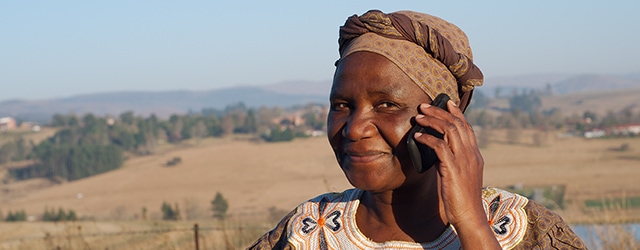Africa's enormous potential for growth is hampered by its citizens'lack of access to banking.

Back To Supplement
Before African banks can meet customer needs, they’re going to have to meet more customers.
“Eighty percent of Africans have no access to any financial institution,” says Caroline Kende-Robb, executive director of the Geneva-based Africa Progress Panel, a group distinguished advisors (such as Kofi Annan, Michel Camdessus and Bob Geldof) who advocate globally for African development. “And without a functioning banking and finance sector there can be no broader transformation.”
Even in the corporate sector, a whole segment is left out. “Banks lend to large corporations; there is plenty of microfinance for small enterprises,” says Amadou Sy, director of the Africa Growth Initiative at The Brookings Institution. “But there’s a ‘missing middle’ of unfunded entrepreneurs.”
Even so, he sees the situation slowly changing “with new players like Equity Bank in Kenya lending to SMEs [small and midsize enterprises], while mobile banking helps individuals’ financial inclusion.”
Kende-Robb points to Safaricom’s immensely successful M-Pesa mobile banking system in Kenya as a pioneer—and not just in terms of leapfrogging traditional banking structures and technologies. “It’s changing how people think about their finances,” she says.
But she also notes that M-Pesa’s success is linked to Safaricom’s having such a large role in the Kenyan market. This has been difficult to replicate elsewhere, as in Nigeria, where there are multiple competitors, or in Uganda, where “it is more of a money transfer system than about savings or making loans.”
“You need interoperability, otherwise it doesn’t work,” says Chris Steward, head of equity research at Investec Asset Management, based in Capetown. He also notes that the rapid growth of a parallel banking system in East Africa was assisted by regulators being at least passively supportive, not subjecting it to the same scrutiny over potential systemic risk as a traditional bank.
Steward observes that mobile banking has taken off in places where there are no viable alternatives because of the lack of bank branches or an established ATM network. Where these exist, as in South Africa, the take-up has been muted.
Kende-Robb notes that, for most women, access to finance doesn’t necessarily involve a formal bank. Loans have been provided by traditional community structures known as chama in East Africa and sou-sous in West Africa. “They take savings and investments and make loans, as in peer-to-peer lending,” she explains. “It’s all based on trust.” The challenge, she says, is to link such informal groupings through a mobile platform with the resources of the formal banking system. Microfinancing for such small entrepreneurs may not be sexy, but default rates are low. “With women,” she adds, “banks are more confident their loans will be paid back.”
New kinds of alliances are now possible. Sy points to local networks like Wari, widely used in West Africa to send city earnings to country villages, as having the potential to open up new markets for traditional banks. As to remittance payments from overseas, he notes that some banks are partnering with Western Union and MoneyGram, a money transfer service.
Greater competition and innovation may increase financial inclusion, but system stability remains the priority of bank regulators. Sy argues for a regulatory framework that looks more carefully at the trade-off between stability and efficiency. “Why should local banks follow standards designed for global banks?” he demands. “That is why there are virtually no entrants into the lending market.”
Steward says that, to date, consumer lending outside South Africa, Namibia and Botswana has been very limited and mainly in the form of payroll-based lending, supported by automatic deductions for repayment. But that’s changing. “We are now increasingly seeing some mobile companies in cooperation with banks providing short-term microloans,” he says.
Establishing credit-worthiness still faces large obstacles. “In many countries personal identification has been an issue, as people living in informal dwellings often don’t have a precise physical address or a municipal account,” says Steward, though he sees some signs of progress. He points out that Nigeria has rolled out a national identity card, while other countries are trying to build behavioral scorecards based on mobile-telephone usage and purchase of prepaid cards to predict how likely it is that a loan will be repaid.
New technology and innovation may open some avenues, but “reserve banks in Africa are generally unlikely to allow fintech companies to operate as banks,” observes Adrian Cloete, portfolio manager at PSG Wealth, an asset management firm based in South Africa. “If an entity is effectively part of the banking system, it needs to be adequately capitalized and meet regulatory requirements as a deposit-taking institution, in my view. So while they can offer some services like payment and money transfers, there needs to be a bank at the back end.”
In some jurisdictions there do exist shadow-banking systems. Cloete argues that “there is the risk that even a small provider of bank-style services can tarnish the whole banking system.”
In Africa, size still matters. “You need scale to meet fixed costs such as IT systems, operational infrastructure, and a compliance department to deal with all the host of regulatory requirements of being able to operate as a bank,” says Cloete. Incumbent giants are not likely to be displaced, but they will have to learn to work more closely with nimbler, more innovative entrants.



